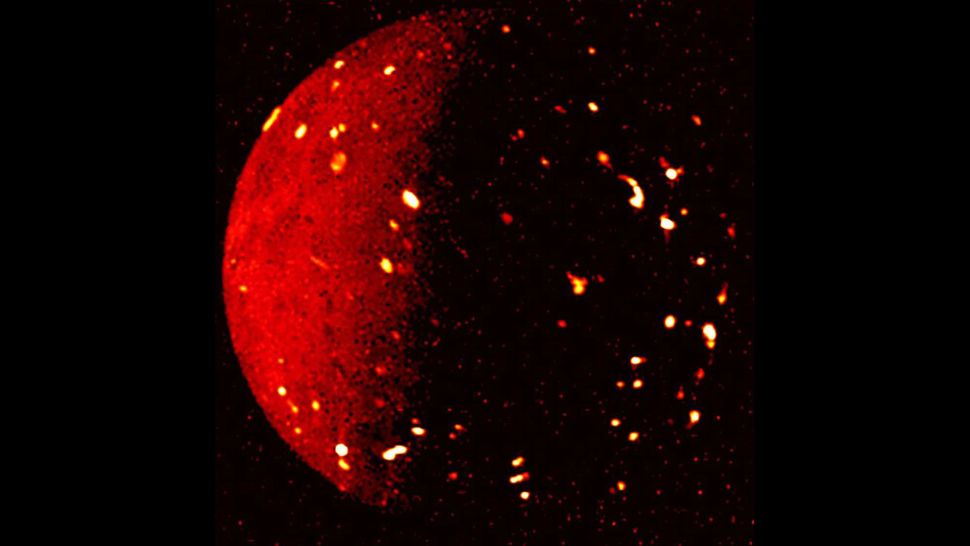After exploring the Galilean moons of Jupiter, Ganymede, and Europa, NASA’s Juno Spacecraft is set to visit Jupiter’s Galilean moon Io, which is the most active volcanic world in the Solar system on December 15.
NASA scheduled its Juno Spacecraft to conduct a flyby on the Jovian moon Io and obtain detailed images of its surface. This mission is part of Juno’s continuing exploration of Jupiter’s inner moons.
What NASA’s Scientists are expecting to learn from using Juno Spacecraft to Capture Io
Juno spacecraft recently received commands from NASA’s control team to capture a detailed view of Io on Thursday, December 15. The spacecraft which has been exploring Jupiter’s orbit since 2016 commenced with the newly assigned task. Io is nearly as big as Earth’s moon. NASA’s control team also scheduled the spacecraft to focus on the moon for the next year and a half while performing a total of nine flybys of Io.
During these flybys missions, the spacecraft will make two close approaches to Io and come within 930 miles (1,500 kilometers) of its surface. At this close distance, the spacecraft will capture a more detailed view of the moon and return the data to Earth. From these flybys, NASA is hoping that scientists will perform the first high-resolution monitoring campaign of Io.
Having a close observation of the magma-encrusted moon will show how Io’s volcanoes and its volcanic eruptions interact with Jupiter’s powerful magnetosphere and aurora. Juno has already made a flyby on Io in the past. In June 2022, the spacecraft flew across the moon at a distance of about 50,000 miles (80,000 km). Unlike ice-encrusted moons like Ganymede and Europa, Io appears to be a very different and unique Galilean moon.
The ice-encrusted moons hide oceans beneath their frozen surface. In fact, scientists are suggesting that some form of lifeform may exist in these subsurface oceans of Ganymede and Europa. But unlike the ice-encrusted moons, Io’s surface is covered in lakes of lava erupting from hundreds of volcanoes spread across the moon’s surface.
NASA revealed that some of these volcanic eruptions can travel up to dozens of miles or kilometers above its Io’s surface. Based on the volcanic activities happening on Io’s surface, scientists are certain that no lifeform could survive and thrive in such an environment. However, scientists are highly inspired to learn more about the most active volcanic world in the solar system.
What Juno Spacecraft Has Accomplished from its extended mission
After NASA extended Juno Spacecraft’s mission to September 2025 in January 2021, the space probe has performed greatly and significantly improve our knowledge about the Galilean moons. During its second year of the extended mission, NASA scheduled the spacecraft to inspect the interior of Jupiter, a close flyby of Ganymede, Europa, and Io. Juno spacecraft has successfully performed a close flyby on Ganymede in 2021 and it also visited Europa on September 29, 2022. NASA’s team of experts is excited about the milestone the spacecraft is accomplishing on its extended mission.
“The team is really excited to have Juno’s extended mission include the study of Jupiter’s moons. With each close flyby, we have been able to obtain a wealth of new information,” said Juno Principal Investigator Scott Bolton of the Southwest Research Institute in San Antonio in a statement. “Juno sensors are designed to study Jupiter, but we’ve been thrilled at how well they can perform double duty by observing Jupiter’s moons.”
After the successful flyby on Ganymede on June 7, 2021, several papers were recently published in the Journal of Geophysical Research and Geophysical Research Letters sharing detailed information about the outcome of the flyby. Information contained in this publication includes the scientific discoveries on the moon’s interior surface composition, its ionosphere, Ganymede’s interaction with Jupiter’s magnetosphere, and other essential data obtained from the close by.
Juno spacecraft also enabled 3D detailed observations of Europa’s icy shell. However, the detailed observation that NASA is expecting from the spacecraft while exploring Io is quite unique. With the measurement gotten from Juno’s Microwave Radiometer (MWR) instrument, scientists were able to observe underneath Europa’s and Ganymede’s icy surface for the first time in history. The instrument was powerful enough to measure the temperature, purity, and structure of the moon’s ice. It even studied up to 15 miles (24 km) depths of their subsurface oceans.
“When we combined the MWR data with the surface images, we found the differences between these various terrain types are not just skin deep,” Bolton said. “Young, bright terrain appears colder than dark terrain, with the coldest region sampled being the city-sized impact crater Tros [on Ganymede].”
Galileo, Cassini, and Voyager are the previous space probes that captured Jupiter and its moons during their missions to deep space. However, the Juno spacecraft has revealed more than enough details about the Jovian system to scientists. However, space agencies are already working towards sending new missions to the Jovian system.
The European Jupiter Icy Moons Explorer (Juice) Mission is already scheduled to launch in April 2023. The spacecraft will fly across space for about eight years before finally arriving at its destination. Europa clipper is another spacecraft that will be visiting the Jovian system in the early next decades. This NASA spacecraft is scheduled to launch in October 2024 and we should be expecting the space probe to arrive at its destination and return unique data to Earth that will help space agencies in planning future space missions to the Jovian system.
Conclusion
As Juno focuses its attention on Io for the next year and a half, we should be expecting to make more scientific discoveries about the most tectonically active world in the solar system. From the data obtained from this mission, NASA and other space agencies will carefully plan future space missions that the Jovian system and beyond. What do you think about this move by NASA?




